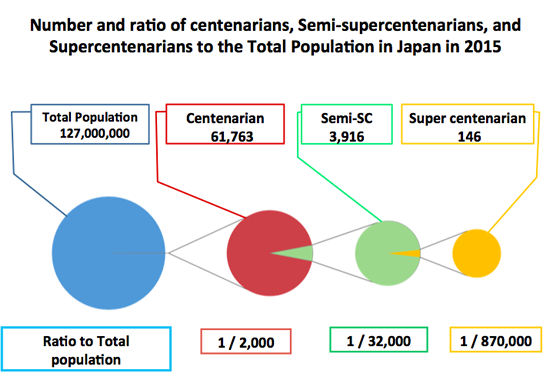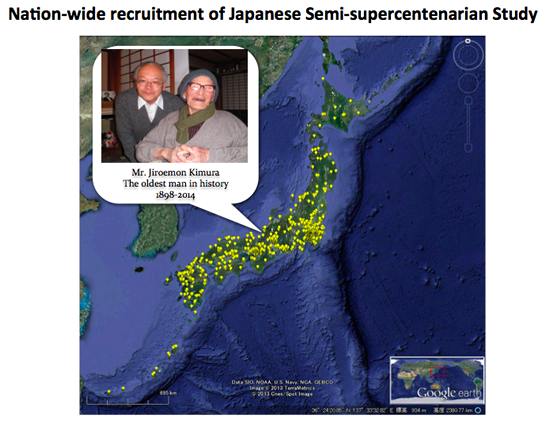The Japan Semi-supercentenarian Study (JSS)
※ participation recruitment is still open
Among centenarians, those who reach the age of 110 are called supercentenarians. What is ‘super’ in this group is not only that they lead long lives, but also that many are living independent lives even at the age of 100, and have a healthy life expectancy over 100 years.
These are the elite of healthy longevity. It is hard to clarify the secrets of why hale centenarians have lived like that for over 100 years. It is extremely rare for humans to reach 110 years of age, and very few people could actually cooperate in the survey. Figure 1 shows the number of centenarians, semi-(over 105 years old) and supercentenarians (over 110 years old) nationwide in Japan, and their ratio to the overall population (from the 2010 census).
Figure 1. Percentage of total population of centenarians, semi- and supercentenarians to the total population of Japan

According to the 2010 census, the total number of people over age 100 was 47,788, whereas there were only 78 supercentenarians. You would find only one supercentenarian in a population of 1.5 million people, which is a very rare group, and very difficult to find. Thus, we focused on the semi-supercentenarian (SSC), those over 105 years old. Based on the results of the TCS, it was known that people with higher ADL levels have the potential to become supercentenarians. We therefore considered we could meet supercentenarians if we followed semi-supercentenarians. In 2002, Dr. Nobuyoshi Hirose began and led the Japanese Semi-supercentenarian Study (JSS). Since semi-supercentenarians are also a rare population (1 of approximately 45,000 people), it was difficult for us to recruit a sufficient number of semi-supercentenarian participants in Tokyo alone, and we broadened the investigation to all of Japan (Figure 2).
Figure 2. Nationwide survey map of semi-supercentenarian participants

As of April 2016, more than 600 semi-supercentenarians have participated in this research. Thus far, we have learned the following from the research on semi-supercentenarians.
- In the elderly in general, the length of telomeres located at the end of chromosomes gradually decreases with age. In centenarians, however, telomere length remains unchanged, especially in semi-supercentenarians and their offspring (children with relatives). Telomere length remained long in centenarians’ offspring even in their 80s, comparable to the average of those in their 60s in the general population (ref 1).
- Chronic inflammation affects life expectancy after 100 years old, ADL, and cognitive function. Suppression of chronic inflammation is considered important for achieving healthy longevity.
- According to the results of brain autopsy of four cases of supercentenarians, Prof. Masaki Takao demonstrated that Neuropathological alterations associated with aging were mild to moderate in the supercentenarian brain, suggesting that these individuals might have some neuroprotective factors against aging(ref 2).
(※ The contents of this research are reported in detail in KOMPAS.)
In our nationwide semi-supercentenarians survey, those 105 years old and over are welcome to join at any time. For details, please see the “Participant recruitment” section.
#1. Arai Y, Martin-Ruiz CM, Takayama M, Abe Y, Takebayashi T, Koyasu S, Suematsu M, Hirose N, von Zglinicki T. Inflammation, but not telomere length predicts successful ageing at extreme old age: a longitudinal study of semisupercentenarians. EBioMedicine 2015;;2(10):1549-58. doi:10.1016/j.ebiom.2015.07.029.
#2. Takao M, Hirose N, Arai Y, Mihara B, Mimura M. Neuropathology of supercentenarians – four autopsy case studies. Acta Neuropathol Commun 2016; 4(1): 97. PMID:27590044; DOI:10.1186/s40478-016-0368-6.

